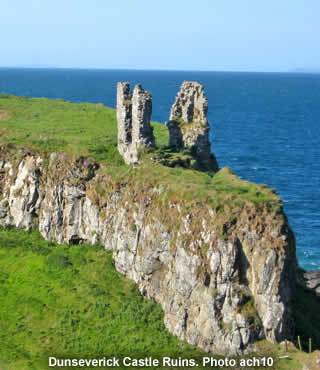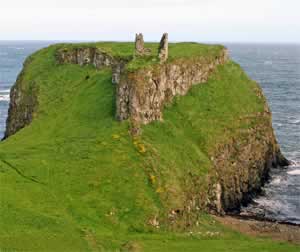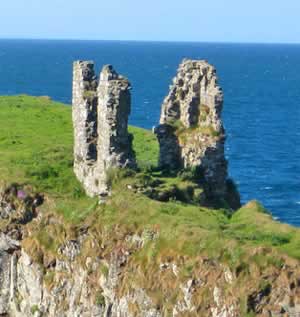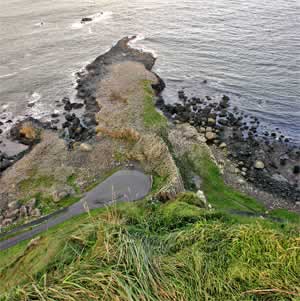Dunseverick Castle |
|
 |
|||
One of the Ireland's most hotly contested castles |
||||
|
||||
These days, Dunseverick Castle is nothing more than a single lump of stone. Perhaps it used to be a wall, or maybe it was part of the gatehouse. No-one really knows. Looking at this lonely remainder, it's hard to picture the formidable stronghold that this once was. It's the location, on a small rock outcrop jutting out into the wild seas of the Atlantic, that suggests just how tough and imposing this place used to be. |
||||
 The remains of Dunseverick Castle. Photo Pdean |
||||
Actually, Dunseverick wasn't just strong, it was important too. A direct road connected it to the town of Tara, where the ancient kings of Ireland used to rule. In the 5th century, Saint Patrick himself was a regular visitor. The country's future patron saint toured the land regularly on his religious mission. Patrick only ever made brief stops, but still wasted no time in baptising most of the locals. One of them, a perfectly normal man called Olcan, ended up becoming a Bishop of Ireland. The baptisms took place at a well on the cliff edge, before the fury of the ocean. It was said to be a holy place, where the water never ran dry. Unfortunately it doesn't seem to exist now. Maybe it was just a legend, or maybe it's still there, buried under a layer of earth. |
||||
 The remaining Castle Walls. Photo ach10 |
||||
In the following centuries, Dunseverick was conquered and occupied by various warlike clans. Each one was constantly trying to improve their domination of Ireland, in back-and-forth battles that raged for years. The castle finally met its end at the hands of General Robert Munro, during the Irish Rebellion of the 1650s. |
||||
According to legend, the one wall that's still visible today is the only part of Dunseverick that General Munro wasn't able to destroy - though it wasn't for lack of trying. Everything else was toppled into the sea but, despite all his attacks, this tiny section was thick and sturdy enough to stay standing. |
||||
In truth, there was at least one other tower left untouched after the General's fateful visit. Nevertheless, Dunseverick's time as a military stronghold was at an end. It had been inhabited by warlords and armies, but by the 20th century the only owner was a local farmer called Jack McCurdy. In 1962 he passed the remains over to the National Trust. A decade or so later the last remaining tower gave in, and crumbled gratefully into the sea. All that was left behind was the single piece of stone still visible today. |
||||
The castle is heavily linked with the old Irish myths of years gone by. The stories weave together all the different sites on the Antrim Coast, like Dunluce Castle and the Giant's Causeway. These places are linked by the Causeway Cliff Path, a spectacular walking route along the best scenery Northern Ireland has to offer. Along the way, it passes by pretty waterfalls and perfect picnic spots. Nothing is ever far away from the roaring ocean, which echoes the battle cries of years gone by. |
||||
 View of the Giant's Causeway from the Causeway Cliff Path. Photo Jasmic |
||||
|
||||
|
||||
Dunseverick Castle can be found on B146 just a couple of miles east of the Giant's Causeway. There is a nearby car-park. |
||||
|
Pocket Britain is optimised for use on a smartphone or tablet with internet access. All content is subject to copyright. All reasonable methods have been used to ensure information supplied is accurate at the time of publication. However, it is advisable to check information before relying on it. Privacy Policy |